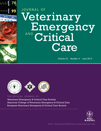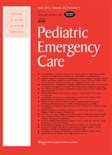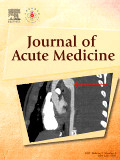
JOURNAL OF VETERINARY EMERGENCY AND CRITICAL CARE
Scope & Guideline
Transforming challenges into solutions in veterinary emergencies.
Introduction
Aims and Scopes
- Veterinary Emergency Medicine:
Focuses on urgent and emergency care for animals, including trauma management, acute illness treatment, and stabilization techniques. - Critical Care Protocols:
Research on intensive care practices, monitoring techniques, and management of critically ill patients, ensuring optimal recovery and survival rates. - Innovative Diagnostic Techniques:
Emphasis on the development and evaluation of novel diagnostic tools and methodologies for rapid assessment of animal health status. - Transfusion Medicine:
Explores blood product usage, compatibility testing, and the impact of transfusions on patient outcomes in veterinary settings. - Toxicology and Poison Management:
Studies on the effects of various toxins, treatment protocols for intoxications, and the management of toxicological emergencies. - Evidence-Based Guidelines:
Development and dissemination of clinical guidelines (such as the RECOVER guidelines) that are based on the latest research to standardize emergency care practices.
Trending and Emerging
- Point-of-Care Testing:
An increasing number of studies are dedicated to the evaluation and application of point-of-care diagnostic tools, emphasizing rapid assessment and timely decision-making in emergency situations. - Telemedicine and Remote Monitoring:
There is a notable rise in research related to telemedicine applications in veterinary care, driven by advances in technology and the need for remote patient monitoring during emergencies. - Transfusion Alternatives and Innovations:
Emerging interest in alternative transfusion products and methods, such as the use of synthetic blood products and novel storage solutions, reflecting ongoing advancements in transfusion medicine. - Advanced Imaging Techniques:
A growing focus on the utilization of advanced imaging modalities, such as computed tomography and ultrasound, for improved diagnosis and management of emergency cases. - Multimodal Pain Management:
Research is increasingly exploring comprehensive pain management strategies, including the use of non-pharmacological methods alongside traditional analgesics to enhance patient comfort and recovery.
Declining or Waning
- Traditional Surgical Techniques:
There appears to be a waning interest in conventional surgical interventions as more emphasis is placed on less invasive techniques and improved recovery protocols. - Basic Life Support (BLS) Techniques:
Though foundational, the frequency of research specifically targeting traditional BLS methods has diminished, likely due to the establishment of standardized guidelines that have shifted focus to advanced life support and innovative approaches. - Epidemiological Studies:
Research that focuses solely on broad epidemiological trends in veterinary emergencies is less common, possibly due to a shift towards more targeted, case-based studies that provide immediate practical applications.
Similar Journals

Notfall & Rettungsmedizin
Elevating the standards of emergency care research.Notfall & Rettungsmedizin is a leading journal in the field of Emergency Medicine, published by Springer in Germany. With a focus on advancing the science and practice of emergency care, this journal offers a platform for original research, critical reviews, and case studies that address the latest challenges and innovations in the field. The journal ranks in the Q2 category of Emergency Medicine for 2023, reflecting its commitment to high-quality scholarship and impactful research, evidenced by its Scopus ranking of #51 out of 109, placing it within the 53rd percentile. Although it does not provide open access, the content is invaluable for researchers, healthcare professionals, and students engaged in emergency medicine. From its inception in 1999 to its continuous publication through 2024, Notfall & Rettungsmedizin remains a vital resource for disseminating knowledge and fostering professional development in emergency care worldwide.

BMC EMERGENCY MEDICINE
Elevating emergency medicine with cutting-edge discoveries.BMC Emergency Medicine is a premier, open-access journal that has been at the forefront of the field of emergency medicine since its inception in 2001. Published by BMC in the United Kingdom, this journal is distinguished by its impact factor and remarkable Q1 ranking in emergency medicine, placing it among the top-tier publications in this vital area of healthcare. With a current Scopus rank of #30 out of 109 in the category of Emergency Medicine, and occupying the 72nd percentile, BMC Emergency Medicine is a leading platform for researchers and practitioners alike to disseminate their findings related to urgent and critical care. The journal embraces a broad scope within emergency medicine, encouraging submissions on a wide range of topics including clinical practice, innovative techniques, public health, and policy issues that critically affect emergency care. The open-access model ensures that high-quality research is readily available to the global community, fostering collaboration and advancing knowledge in the field. For those dedicated to improving patient outcomes in emergency settings, BMC Emergency Medicine represents an invaluable resource and community.

Canadian Journal of Emergency Medicine
Pioneering Insights for Today's Emergency ChallengesWelcome to the Canadian Journal of Emergency Medicine, an esteemed publication in the field of Emergency Medicine published by SPRINGER HEIDELBERG. With its ISSN 1481-8035 and E-ISSN 1481-8043, this journal serves as a vital resource for cutting-edge research and reviews from 1999 to 2024, maintaining a prominent position in the academic landscape as evidenced by its Q2 ranking in the Emergency Medicine category and a commendable Scopus ranking of #35 out of 109 journals. The journal is committed to advancing medical practices and improving patient outcomes through rigorous- peer-reviewed articles that address contemporary challenges and innovations in emergency care. Though it is not an open-access publication, it remains an essential platform for sharing knowledge among health professionals, researchers, and students dedicated to optimizing emergency medical services and enhancing overall healthcare delivery.

PEDIATRIC EMERGENCY CARE
Delivering Critical Insights for Pediatric Emergency ProfessionalsPediatric Emergency Care, published by Lippincott Williams & Wilkins, serves as a vital resource within the fields of Emergency Medicine, Pediatrics, and Child Health. Established in 1985, this journal offers a platform for the dissemination of impactful research, offering critical insights for healthcare professionals dedicated to improving emergency care for children. With an impressive impact factor, it ranks in the Q2 category in Emergency Medicine and Pediatrics, highlighting its significance in advancing clinical practices and outcomes. Although not an open-access journal, it provides extensive access options to ensure the research is available to a broad spectrum of readers. The journal's rigorous standards and commitment to excellence make it an essential tool for researchers, practitioners, and students aiming to stay at the forefront of pediatric emergency care advancements.

Turkish Journal of Emergency Medicine
Pioneering insights for critical moments in medicine.Turkish Journal of Emergency Medicine, published by Wolters Kluwer Medknow Publications, is a premier Open Access journal dedicated to advancing the field of emergency and critical care medicine. With an ISSN of 2452-2473, the journal has established a global readership since its inception in 2014, ensuring that groundbreaking research is accessible to all. Situated in Turkey, this journal has been recognized for its significant contributions to the medical community, currently holding a Q2 rank in both Critical Care and Intensive Care Medicine and Emergency Medicine as of 2023. The journal aims to publish insightful articles that cover a wide range of topics within its scope, making it a crucial resource for researchers, healthcare professionals, and students who are committed to improving patient outcomes in emergency settings. Accessible online, it fosters collaboration and knowledge sharing across borders, positioning itself as an essential platform for the latest advancements in this critical discipline.

Clinical and Experimental Emergency Medicine
Elevating emergency medicine with cutting-edge insights.Clinical and Experimental Emergency Medicine, published by the SEOUL KOREAN SOCIETY OF EMERGENCY MEDICINE, is a premier Open Access journal dedicated to advancing knowledge and practice within the fields of emergency medicine and emergency nursing. With an ISSN of 2383-4625 and an E-ISSN of 2383-4625, this journal has established itself prominently in the academic community, achieving a notable Q2 ranking in both Emergency Medicine and Emergency Nursing categories in 2023. The journal is committed to providing highly relevant research, innovative clinical practices, and educational resources that address the urgent and evolving challenges in emergency care. With a vision to foster collaboration among researchers, practitioners, and students, it aims to contribute significantly to the body of knowledge that enhances emergency medical services and improves patient outcomes globally. Accepting submissions and offering Open Access since its inception in 2014, the journal is positioned as a key resource for those dedicated to the advancement of emergency medicine.

Journal of Emergencies Trauma and Shock
Elevating standards in emergency medicine through open-access research.The Journal of Emergencies Trauma and Shock, published by Wolters Kluwer Medknow Publications, is a premier open-access journal dedicated to advancing the field of emergency medicine. With an ISSN of 0974-2700 and an E-ISSN of 0974-519X, this journal has been a vital resource since its inception in 2008, providing a platform for original research, reviews, and clinical studies pertinent to trauma and shock management. The journal is recognized for its significant contributions to the field, illustrated by its strong standing as a Q2 journal in Emergency Medicine and ranking #34/109 in Scopus, with a commendable 69th percentile. Based in Mumbai, India, the journal not only reaches local practitioners but also caters to an international audience with its commitment to disseminating high-quality research that influences practice and policy in emergency settings. The publication is especially respected for its innovative approaches and practical findings that inform healthcare professionals on the front lines of trauma care. Researchers, practitioners, and students alike will find invaluable insights and data that help to shape the future of emergency medicine.

Journal of Acute Medicine
Fostering collaboration for enhanced emergency care solutions.Journal of Acute Medicine is a pivotal platform for disseminating cutting-edge research within the fields of Critical Care and Intensive Care Medicine and Emergency Medicine. Published by the Taiwan Society of Emergency Medicine in the Netherlands, this journal serves as a vital resource for healthcare professionals and researchers devoted to advancing acute medical practice. With an ISSN of 2211-5587 and an E-ISSN of 2211-5595, the journal features a collection of high-quality articles that focus on the latest developments and challenges facing emergency healthcare systems. Since its inception in 2011, the journal has achieved a respectable Q3 ranking in both critical care and emergency medicine categories, demonstrating its commitment to scholarly excellence. Although it currently does not operate as an open-access publication, the journal provides a critical forum for exchanging knowledge, fostering collaborations, and enhancing clinical practices, ensuring that it remains an essential read for those involved in acute medical care.

Current Emergency and Hospital Medicine Reports
Transforming Emergency Medicine with Evidence-Based KnowledgeCurrent Emergency and Hospital Medicine Reports, published by Springer, is a pivotal journal in the field of emergency and hospital medicine. With a commitment to disseminating crucial research and advancements, this journal serves as a platform for sharing high-quality studies that enhance clinical practices and improve patient outcomes. As an important resource for researchers, healthcare professionals, and students, it caters to the growing need for evidence-based knowledge in emergency medicine. Although currently not classified as open access, the journal offers a wealth of information that aligns with the latest innovations and practices in the discipline. By engaging with diverse topics, from clinical interventions to hospital management strategies, it aims to inform and inspire the next generation of practitioners and scholars in this vital field of medicine. With its ISSN of 2167-4884, Current Emergency and Hospital Medicine Reports is dedicated to advancing the frontiers of emergency healthcare through rigorous research and illuminating insights.

ANASTHESIOLOGIE & INTENSIVMEDIZIN
Elevating Standards in Anesthesiology and Critical CareANASTHESIOLOGIE & INTENSIVMEDIZIN is a peer-reviewed journal dedicated to the fields of anesthesiology, critical care, and intensive medicine. Published by AKTIV DRUCK & VERLAG GMBH in Germany, this journal has been an essential resource in the medical community since its inception in 1978. With a current impact factor placing it in the Q3 quartile in both anesthesiology and critical care categories, it serves as a platform for disseminating cutting-edge research and innovative practices. The journal invites contributions that enhance the understanding of pain management, perioperative care, and intensive treatment methodologies. Although not open access, it remains committed to advancing knowledge and improving patient outcomes. With a strong focus on practical applications, ANASTHESIOLOGIE & INTENSIVMEDIZIN is invaluable for researchers, clinical practitioners, and students seeking to deepen their expertise in these crucial areas of healthcare.